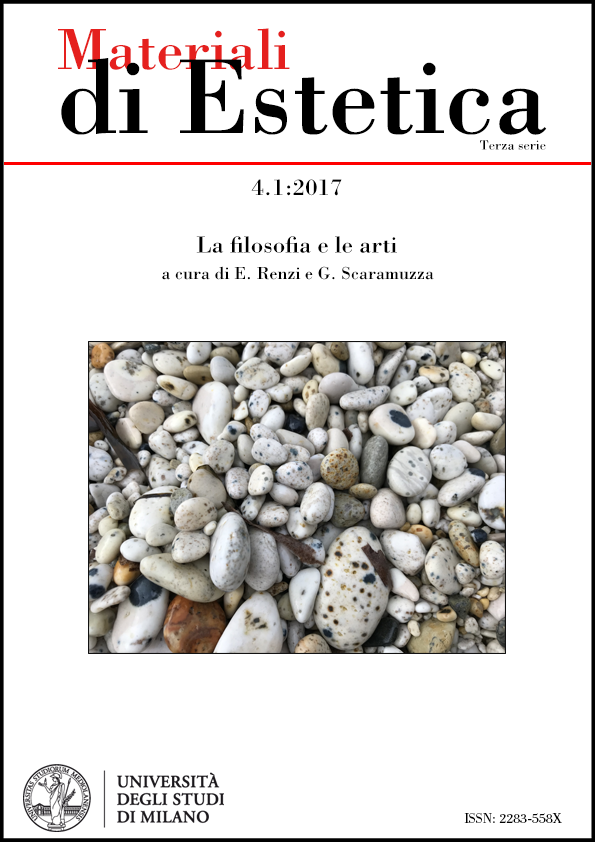L’arte come paradigma ideale in Filone d’Alessandria
DOI:
https://doi.org/10.13130/mde.v%25vi%25i.9551Abstract
For Philo the unique true artist is God who makes the Great City, the world. He designs a plan and, being the author of the eternal paradigms, he produces many perfect shows: the dance of the stars, the heavenly music, the echo of non-visible sounds. In the human world, art to be true art and not a form of falsehood, must follow noetic patterns. We can see this aspect in the visual arts, where an artist acts -Bezalel- who draws inspiration from divine indications. Phidias too, even if he is not inspired, brings the ideal types in the matter. There is an ontological descent from the divine work to the products imitating ideal paradigms, to the artifacts gifted with an empirical agreeableness, even if they do not ascend to the idea. In the literary field too, the texts of authors such as Solon or Plato show elements of truth: they are third level works, but they are not negative. The status of the theatre is quite different: the performances seem necessarily to involve forms of falsehood, simulation, deceit. My hypothesis is that the theatre has a particular role: it is its own nature to be false, not simply illusion, but real deception. It is not a question of being an inferior copy of an ideal eternal model, but of being actually falsehood and lie. Thus, for Philo theater is at a much
inferior level than the other arts and in this, Philo is quite different from Plato.
Riferimenti bibliografici
ALBANO, Emmanuel, I silenzi delle Sacre Scritture. Limiti e possibilità di rivelazione del Logos negli scritti di Filone,Clemente e Origene, Institutum Patristicum Augustinianum, Roma 2014.
ALEXANDRE, Monique, “La culture profane chez Philon”, in Colloque Philon d’Alexandrie, Lyon 11-15 Septembre 1966, Éditions du Centre National de la Recherche scientifique, Paris 1967.
AMIR, Yehoshua, “The Decalogue according to Philo”, in B.-Z. Segal (ed.), The Ten Commandments in History and Tradition, english version ed. by G. Levi, Magnes Press, Jerusalem 1990, pp. 121-160.
CALABI, Francesca, “Il governante sulla scena. Politica e rappresentazione nell’"In Flaccum" di Filone alessandrino”, in Ead. (a cura di), Immagini e rappresentazione. Contributi su Filone di Alessandria, Binghamton, Global Publications, New York 2002, pp. 45-57.
—, “Conoscibilità, inconoscibilità di Dio in Filone di Alessandria”, in Ead. (a cura di), Arrhetos Theos. L’inconoscibilità del principio nel medio platonismo, ETS, Pisa 2002, pp. 35-54.
CHALIER, Catherine, Sagesse des sens. Le regard et l’écoute dans la tradition hébraïque, Albin Michel, Paris 1995.
DESTRO, Adriana, PESCE, Mauro, Antropologia delle origini cristiane, Laterza, Roma-Bari 1995.
GUTMANN, Joseph, “The ‘Second Commandment’ and the Image in Judaism”, Hebrew Union College Annual, 32, 1961, pp. 161-174.
KOSKENNIEMI, Erkki, “Philo and Classical Drama”, in J. Neusner et alii (eds), Ancient Israel, Judaism and Christianity in Contemporary Perspective: Essays in memory of Karl-Johan Illman Studies in Judaism, University Press of America, Lanham-Boulder-New York, Toronto, Oxford 2005.
LANZA, Diego, “L’attore”, in M. Vegetti (a cura di) Introduzione alle culture antiche, Bollati Boringhieri, Torino 1992.
LÉVINAS, Emmanuel, Nomi propri, a cura di F.P. Ciglia, Casale Monferrato 1984.
—, Altrimenti che essere o aldilà dell’essenza, tr. it. di S. Petrosino e M.T. Aiello, Milano 1991.
L. LUGARESI, “Tra evento e rappresentazione. Per un’interpretazione della polemica contro gli spettacoli nei primi secoli cristiani”, Rivista di storia e letteratura religiosa, 30, 1994, 437- 464.
—, “Spettacoli e vita cristiana nelle orazioni di Gregorio Nazianzeno”, Annali di storia dell’esegesi 15, 1998, pp. 441-466.
—, “Il teatro di Dio: il problema degli spettacoli nel cristianesimo antico (II-IV secolo)”, Adamantius Supplementi, 1, 2008.
MENDELSON, Alan, Secular Education in Philo of Alexandria, Hebrew Union College Press, Cincinnati 1982.
NIETO HERNÁNDEZ, Pura, “Philo and Greek Poetry”, SPhA, XXVI, 2014, pp. 135-150.
NIKIPROWETZKY, Valentin, “Sur une lecture démonologique de Philon d’Alexandrie”, De Gigantibus, 6-18, in AA.VV., Hommage à G. Vajda, Louvain 1980, pp. 43-71.
RUNIA, David Theunis, Philo of Alexandria and the Timaeus of Plato, Brill, Leiden 1986.
—, “Polis and Megalopolis: Philo and the Founding of Alexandria”, Mnemosyne, IV, 3/4, (1989), pp. 398-412.
—, On the Creation of the Cosmos According to Moses, Brill, Leiden 2002.
SANDELIN, Karl-Gustav, “Philo’s Ambivalence towards Statues”, SPhA, 13, 2001, pp. 122-138.
SIMEONI, Luca, “L’Epinomide, vangelo della religione astrale”, in F. Alesse, F. Ferrari (a cura di), Epinomide. Studi sull’opera e la sua ricezione, ediz. multilingue, Napoli, Bibliopolis 2013, pp. 179-200.
VEYNE, Paul, Le pain et le cyrque. Sociologie historique d’un pluralisme politique, Seuil, Paris 1976.






